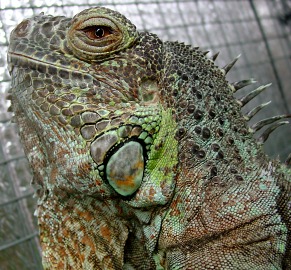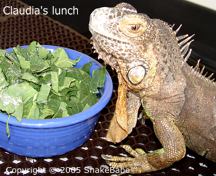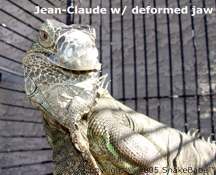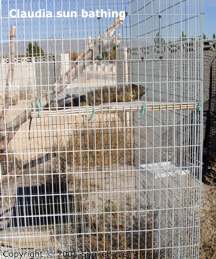Green Iguana Care
Scientific Name: Iguana, iguana (did I stutter?)
Homeland: Central and South America
Size: I have read they average 4 to 6 feet but I have never seen one with a body (nose to vent) larger than 4 feet. Some weight up to 15 pounds
Lifespan: I have read up to 20 years, but my experience is 11-15 years
I highly recommed reading one of my favorite iguana articles here...www.anapsid.org/iguana/killingigs.html
Cage:
Tall is good. Very good. As your little guy grows he will climb more often. This is good. My female is in a cage that is 6 feet high and 3 feet deep and five feet wide. There is a large water bin in the bottom big enough for her to soak in and easy to remove to clean. She has the habit of pooping in her water so I sometimes clean it twice a day.

Substrate:
I use the Rubber Mats (see general care) I do not recommend bark or stone products as iguanas can ingest it. Most iguanas we take in are impacted with bark and do not recover.
Temperature:
I use radiant heat panels. At the bottom of her cage temperatures start at 80 and rise up to 95 at the top closest to the heat panel. No hot rocks! Ever. (see my general care on heat panels)
Humidity: I use a steam vaporizer each night for approx 8 hours. They are tropical, so please give them what they would have in the wild.
Shedding:
They do shed in patches. Not like snakes. As long as it is humid they will shed just fine.

Feeding: Iguanas are herbivores. Try some collard greens, dandelion greens, mustard greens, turnipgreens, parsley and lots more. No lettuces, they have no nutritional value. Also no spinach, it binds calcium. I also use a vitamin powder called Miner-all. They have two kinds, one for when they guys get natural sunlight and one for when they get mostly artificial light in the winter. I get all my greens delivered to me from www.reptigreens.com Pieces of fruit and vegetables work great as treats. I also offer a commercial iguana chow diet but not everyday. They love it but I have to add a bit of water to soften the chunks. Variety is important to iguanas and a dark green leafy vegetables supplemented with the pellet diet is a good combination to start.

Both Caudia and Jean-Claude had metabolic bone disease when they came to us. Claudia received calcium injections and both were put on a high sunlight high quality diet.
Lighting:
Natural sunlight is so much a vital part of their life. Their bones will not develop properly without it. Not through a window, but direct to bask in. Sunlight contains U.V. rays necessary for life in many lizards and if you think I am off here call a reptile vet. All my reptiles get natural sunlight. Your iguanas need it to be their healthiest no matter what the pet shop says.
Have a cage, NOT a glass aquarium, but an open-air cage on your patio, in your yard or by an open window. Put your lizard in there and let him soak up the rays. He will feel better, bite less and get those bright eyes and beautiful colors you want. Please keep inmind if it is too hot you could cook the little guy so make sure temps do not exceed their tolerance limits. If their mouth is open it is too hot. Possibly place them in a tree shadow so the light is there but not too intense. This will provide UV radiation necessary for the synthesis of vitamin D and allow the reptile body to absorb calcium. In the winter this can be a problem. How can you put your sunlight needing reptile out in the yard when the cold will kill him? Answer is full spectrum lighting. I prefer natural sunlight, but is the next best thing. A florescent light tube (never the screw in kind) that copies a little bit of the sun. I have been using Vita-lite brand as far as I can remember with great success. There are now a zillion lights on the market claiming to have full spectrum capabilities. As my time allows I will put more information on this subject later. There is much available on the Internet now if you search.
This and That:
I rarely recomend them as pets. I know that this will anger a lot of Iguana owners but my experience is that people tend not to do all that is necessary to care for them properly. A bowl of water and some lettuce is what I see all the time and it breaks my heart to see these wonderful lizards suffer. Any animal I give a low pet recomendation to is based on the ease of care. The more difficult to care for the more neglect I see. Iguanas in aquariums so small they cannot turn around in and where the only heat source is a hot rock. You look at the underside of these pets and see burns. Like big snakes I believe they are too much for most people, especially children, to care for properly. When cages are not kept clean they can also transfer salmonella to children.